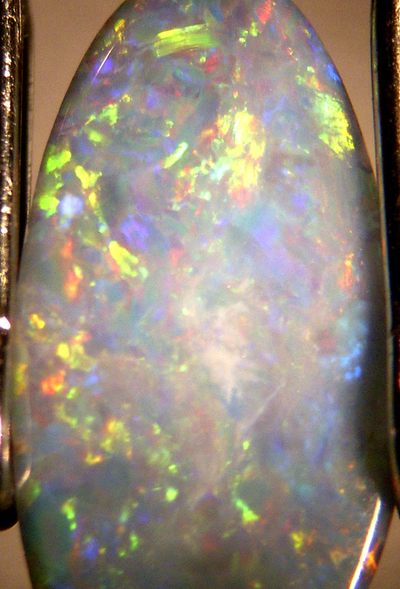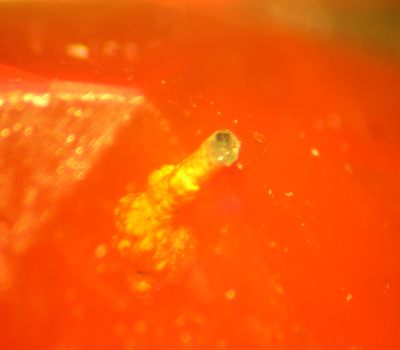Opal
It's a lucky stone
Treated stones and synthetics
Doublets and Triplets
Fire opals, and caring for all opals

A beautiful play of colours show in this opal doublet - and it
looks even better in real life, as the effects change when the
stone is moved. Look closely, and you'll note the centre of
the stone is rather dull. And that's why it's never been
mounted in a piece of jewellery. The pictures does not reveal the
way the coloured zones are actually inside, not on the surface,
of the gem. Click here
for larger image (267KB).
Opal consists of minute spheres of silica, separated by air and
water. Normally the spheres are of random size, and the stone is
translucent, and not of any use in jewellery - it's called
common opal. But light is split as by a prism on passing through
the spheres, so if the spheres are all the same size, the light
is seen as brilliant flashes of colour (fire), the exact shade
depending on your viewing angle and the size of the spheres.
Breaks in the array of spheres cause the hard edges between
different areas of colour.
Back to top

A synthetic opal removed from a scrap ring; good play of colour,
but the sharply defined areas of colour (chicken-wire effect)
reveal it as synthetic. Like natural opal this stone is soft and
some scratches and damage are visible, especially in the larger
image. The colours of synthetic opal are superb, but we find most
people do prefer the natural stone.
Click here for
larger image (151KB).

A hornblende rod with accretions is embedded in this fire
opal. The light coloured area to the left is a reflection from
another facet. Click here
for larger image (197KB).
Back to top
It's a Lucky Stone
In Classical times the opal was highly regarded. Mark Anthony
outlawed a senator who refused to yield his opal! The stone was
believed to bring good fortune, and warn of poison. Along with
many other stones, it was considered a protection against
disease
So why is it considered unlucky by some?
One theory suggests that in 1829 Sir Walter Scott published Anne of Gerstein. One
of the characters wore an opal which changed colour according to
her mood. Holy Water was sprinkled on the stone, and she fainted
and then died. Sales of opal collapsed. But not for long. Queen
Victoria loved the stone, and soon its popularity was
restored.
Another suggestion I've heard is that in the past opals often shattered.
So plague victims frequently were found wearing shattered opals; an unfortunate but logical
connection was made! Again there is no need to worry about this legend. Modern
opals seldom shatter. The issue is better understood, and stones are carefully treated to avoid the
problem. Also most are sourced from Australia, where the stones are much less prone to breaking up.
Back to top
Treatments before Purchase
Opal can be impregnated with oil, wax or resin to conceal
flaws and enhance the colours. Resin is permanent but oil or wax
will be lost with time. So buy from a reputable source.
Also synthetic opals are produced, and can be hard to identify;
see the picture of a synthetic on this page. Again a dealer who
knows the trade will help you buy the genuine article.
Doublets and Triplets
Precious opal is valuable, and the better the fire the greater
the cost. To make it more affordable, some of the very best is
thinly sliced, and cemented to a cheap backing (often black onyx). Black glue is
often used, as that enhances the colours.
Triplets use even less opal, as a very thin layer of opal is
protected by a top covering of glass or quartz.
These stones give a beautiful effect at an affordable price, so
are worth considering. However they do require extra care, as
water can seep between the layers. You must choose between a
longer-lasting real opal, or accept the disadvantages of a
doublet in return for greater beauty at the same price.
Fire Opal
It's common opal stained by iron oxide, which gives it a beautiful
colour. The stone. being composed of tiny spheres - like all opal
- is translucent. On rare occasions, when the spheres are the
right size and alignment, flashes of colour are visible, as in
precious opal.
Caring for Opal
Along with many other semi-precious stones, opals can be
scratched if worn (especially in rings) when doing rough work -
and a badly scratched opal will lose much of its beauty. The
stones are slightly porous, so should not be soaked in anything.
So never wear them when working. Keep them for fun times.
Badly scratched opals can be re-polished, but there is always a
small risk they will shatter while being polished. Consult your
jeweller for further information.
Back to top



